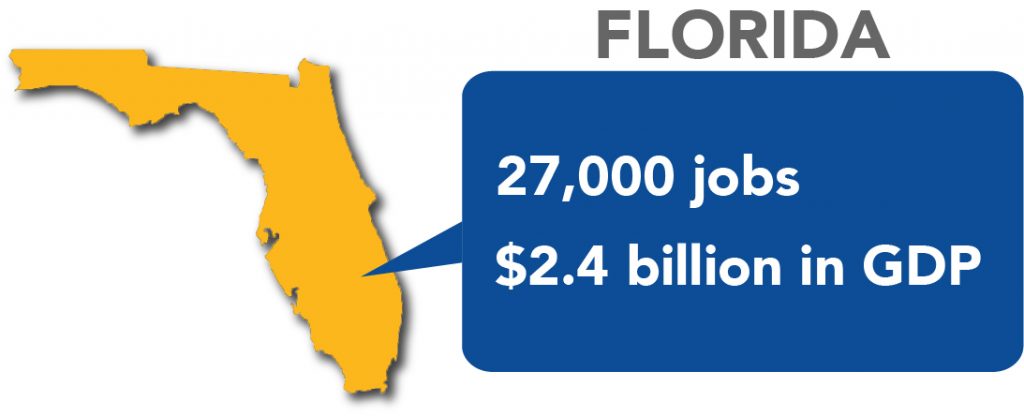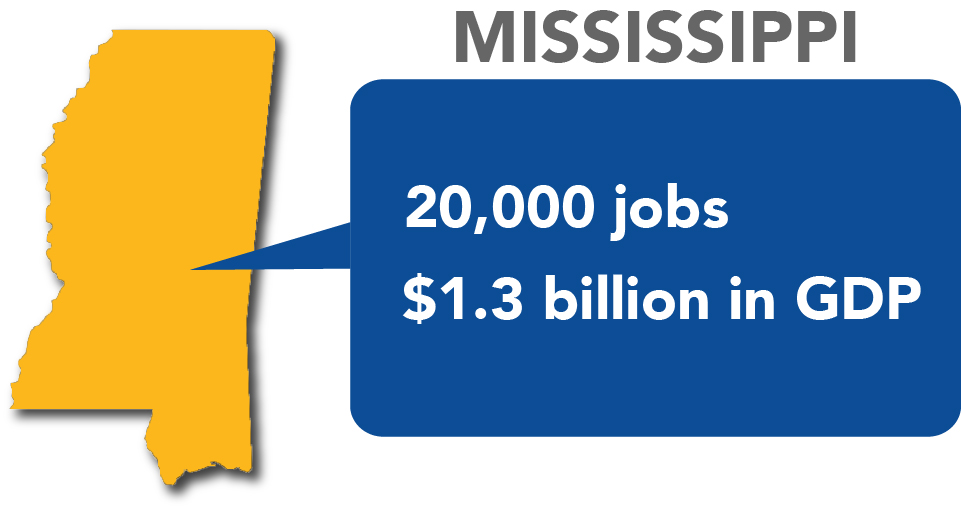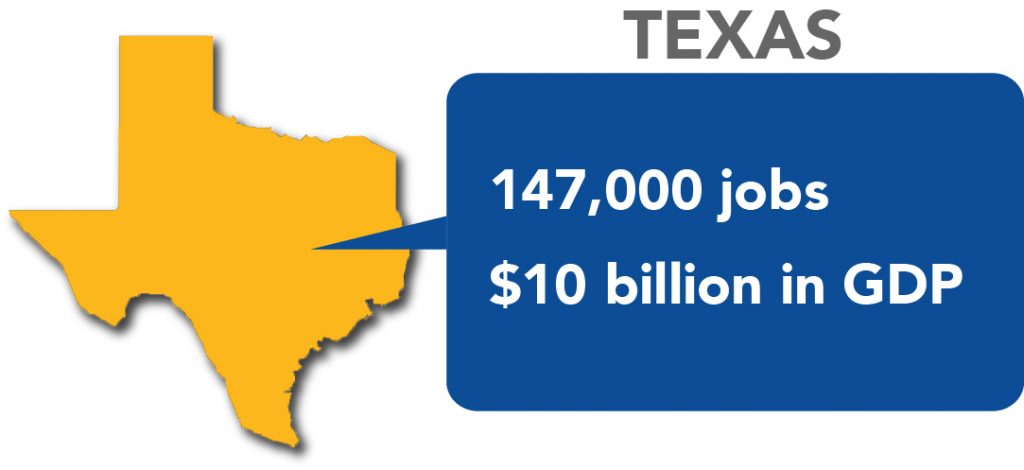ENERGY DEVELOPMENT IN THE GULF OF MEXICO – WHAT’S AT STAKE?
OUR SAFETY AND THE ENVIRONMENT
A 2016 study from the Obama Administration highlighted that the country’s greenhouse gas emissions wouldn’t be greatly impacted by leasing in the Gulf of Mexico. In fact, those emissions may be higher without Gulf of Mexico development. Without this development, the U.S. will have a greater reliance on foreign oil meaning higher emissions and would slow America’s world-leading environmental progress.
Continuing development in existing areas of the Gulf ensures the energy we produce and consume energy is done so with the world’s strongest environmental and safety standards. Knocking the Gulf out of production would mean that countries with poor environmental records and lower standards are providing the energy American families and businesses need.
It’s important to note that even with all our energy production, America has still achieved the largest absolute decrease in carbon dioxide emissions of any country since 2000, according to the International Energy Agency. Last year, we had the largest absolute reduction, 140 megatons, while China accounted for most of Asia’s 320 megaton emissions increase. The U.S. is more than two-thirds of the way to its emissions reductions goals under the Paris Climate Accord 2025 targets.
America pays as much attention to safety as it does the environment since they go hand-in-hand. Regulators and industry alike in recent years have taken unprecedented steps to further increase safety and environmental protections, including the following actions:
- Updated exploration and development standardsand processes
- Created new well design and casing standards
- Updated existing safety and environmental management systems(SEMS) rule to maximize workplace safety for offshore operations
- Issued new blowout preventer requirements and well control rules
- Increased inspection and engineering workforce
- Supported institutions such as the Ocean Energy Safety Instituteand the Center for Offshore Safety
– President Barack Obama (SOURCE)
TRADITIONAL RESOURCES IN THE GULF
The Gulf of Mexico holds an estimated ~48 billion barrels of oil and ~142 trillion cubic feet of undiscovered oil and natural gas,[1] making it a huge source of reliable and affordable energy that powers our modern lives.
If used to generate electricity, the oil alone is enough to power all 128.5 million households in the U.S. for more than two years, based on Energy Information Administration data – and do lots more, too.
Already, the Gulf supplies nearly 17% of the nation’s crude oil production, and existing Gulf development generates significant economic benefits to Gulf Coast states. In FY 2019 alone, Gulf of Mexico activity supported 345,498 jobs, over $28 billion in GDP, and $5 billion in government revenue.
[1] Undiscovered but technically recoverable resources (UTRR).





Traditional resources in the Gulf of Mexico don’t just help state and local economies, but benefit Americans across the country by funding conservation projects and National Parks.
- In Fiscal Year 2020, the Gulf States received almost $249 million for critical coastal conservation, restoration, and hurricane protection projects (In FY 2019, $353 million was distributed)
- $900 million in funding for the Land and Water Conservation Fund primarily comes from federal offshore oil and gas leasing
- The Gulf offers a funding source for the Great American Outdoors Act benefiting national parks, forests, wildlife refuges, and American Indian schools
It is critical to continue to keep these programs healthy by continuing leasing in existing areas of the Gulf of Mexico.
According to a recent study by National Ocean Industries Association (NOIA), production, employment, GDP and tax revenues from the Gulf of Mexico (GOM) Outer Continental Shelf include the following:
2019: Production of more than 2.3 million barrels of oil equivalent per day
2020-2040: 2.5 million barrels of oil equivalent per day (Forecasted)
2019: 345,000 jobs across the country
2020-2040: 370,000 jobs across the country annually (Forecasted)
2019: $28.7 billion contribution to U.S. GDP
2020-2040: $31.3 billion contribution to GDP annually (Forecasted)
2019: $5.4 billion in tax revenues for the government
2020-2040: $7 billion in tax revenues (excluding income & property taxes) annually (Forecasted)
2019: $353 million in revenues to producing Gulf states, $1 billion to the Land and Water Conservation Fund
2020-2040: $374 million in revenues to producing Gulf states, $1.3 billion each year to the Land and Water Conservation Fund (Forecasted)
Conversely, this same study cautioned that a potential leasing ban would result in:
- An initial 20% decrease from 2.5 million barrels to 2.0 million barrels per day
- By 2040, production would fall to approximately 910,000 barrels/day
- Employment would decline 28% to 268,000 jobs from 370,000 jobs GDP would fall almost 30% to $22.1 billion from $31.3 billion
- Government revenues would plunge 26% to $5.2 billion from $7 billion annually
Continued and expanded access to all areas of the Gulf of Mexico will increase these economic gains for Gulf Coast residents and ensure that the Gulf Coast continues to supply American consumers across the country with reliable crude oil, petroleum, products and natural gas.
– Richard A. ‘Tony’ Bennett, President, Texas Association of Manufacturers (SOURCE)
RENEWABLE RESOURCES IN THE GULF
Wind energy will not only be an important contribution to our nation’s energy mix onshore, but also in the future production of offshore energy in the Gulf of Mexico. While most people traditionally think of wind farms on land, offshore wind has the ability to bring size and massive economies of scale needed to bring low-cost carbon-free energy to our nation’s communities. These are not your father’s wind farms. While these offshore wind farms are established in Europe, they are relatively new to North America. The industries potential output, economic benefits, and ability to diversify our energy mix – bringing greater energy independence – is vital to our nation.
Outside of the Atlantic and Pacific water, the potential for production in the Gulf of Mexico alone for offshore wind is roughly 508 gigawatts.
Current economic activity supported from the construction and operation of a 600 MW Gulf of Mexico offshore wind development:
- Construction of the turbines provides:
- 4,472 jobs
- $445 million in GDP
- Operation of the turbines provides:
- 151 jobs
- $14 million in GDP
Embracing new offshore energy development of all types can provide a significant source of funding for activities ranging from infrastructure improvements and environmental restoration to conservation initiatives and expanded public access to recreation sites and trails in our National Parks.

Our energy challenges are economic development opportunities.
– Kevin Law, president and CEO of the Long Island Association (SOURCE)
OUR SECURITY
A leasing ban or failure to issue federal permits on public land and waters would force the U.S. to import the displaced oil from other mineral rich countries. It would also undermine our position as the world’s largest oil and gas producer, which insulates our economy from the price shocks that we suffered for decades when we relied on foreign nations for our energy needs.
American production means geopolitical turbulence or price manipulations don’t turn into higher prices at the pump and all across our economy. Currently, about 22% of US oil production and 12% of natural gas production takes place on federal lands, according to SP Global, with 60% of the country’s permits in one of the poorest states in the nation – New Mexico, which heavily relies on the revenue to meet state budget requirements. Federal waters based development accounts for roughly 15% of total oil production and roughly 3% of natural gas production.
Worse, it will harm our position as the world’s biggest reducer of emissions.
Asia is rising economically – and is thirsty for oil. The price pressures on oil and oil price shocks, due to Asia’s economic rise, mean that all steps made now to reduce oil dependence will protect us from pain and volatility later.
– Van Jones, CNN Commentator (SOURCE)
DID YOU KNOW?
Limiting new development in the Central and Western Gulf hurts more than just families and businesses – they limit funding to national parks, coastal communities, and halt renewable energy development too!
Despite the myriad benefits that come from offshore wind and traditional fuel development offshore – notably money to protect and conserve our national parks and coastal states –
Through these bans, your leaders are locking up energy resources and shutting down the opportunity for jobs in both wind and traditional energy. These offshore moratoriums will not help us meet the energy goals proposed in states across the nation and will hinder our ability to be energy independent.
Learn what is really at stake when you ban energy development.
Contact your elected officials if you want to see money to conserve our favorite outside places and meet our energy needs here at home!
TAKE ACTION
Now is the time to speak up for developing our resources in the Gulf of Mexico.
Families and businesses across the United States, especially individuals on fixed and low income and small businesses, depend on affordable, reliable energy to make ends meet and support their families and employees. Furthermore, increasing opportunities to develop our own resources here at home will provide economic growth that will help our children and grandchildren.
A study shows that between 2020 and 2040, expanded development could support just under 292,000 jobs, over $31.3 billion in Gross Domestic Product per year, and $7 billion per year in projected government revenues. At the same time, by developing energy here in America under our stringent regulatory standards, we will continue to help safeguard our environment.
To meet America’s growing and long-term energy needs, it is vital to keep significant offshore opportunities in place and not play political games with our indispensable energy resources.
